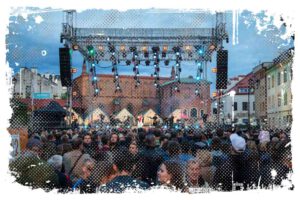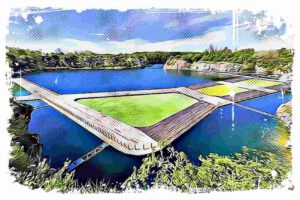Right in the heart of Krakow, Poland, there’s a small and special area, St. Mary’s Square. Let me tell you, it is more than just a square. It is an integral part of Krakow’s market. Located next to the bustling Main Market Square and associated closely with St. Mary’s Basilica, this square holds its unique status – administratively independent.
Such independence, I believe, is largely shaped by its rich history. If you want to breathe in some history, you need to know, it’s right there, in St. Mary’s Square, which has been witnessing the turbulent times of the capital city since the Middle Ages.

If you’re interested in Krakow I suggest you read this article about the most important attractions you can find around old town and Krakow’s .Market Square.
St. Mary’s Square – The Lively Atmosphere Place
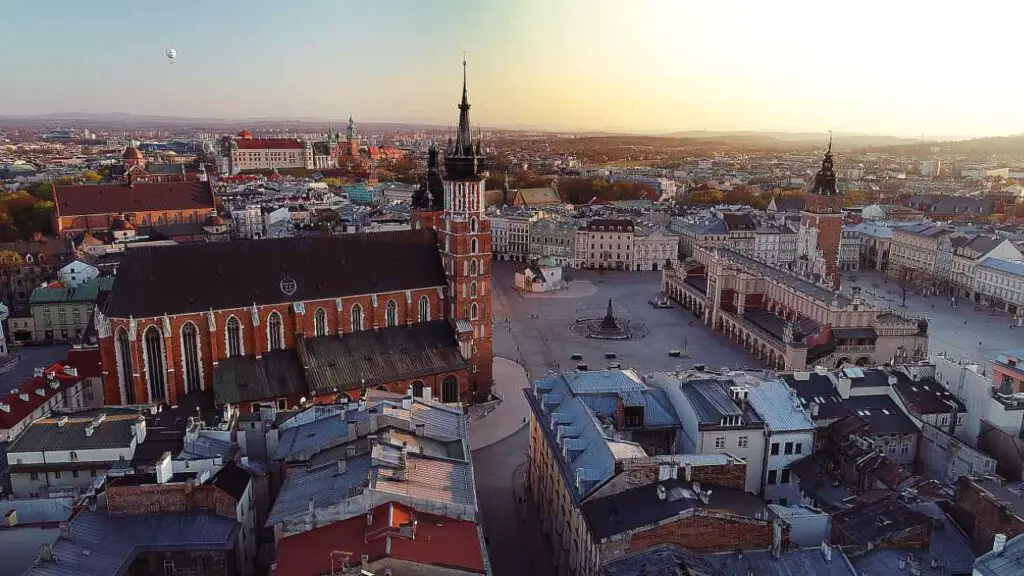
Not just the iconic Basilica, but St. Mary’s Square itself is a lively hotspot. The square is always buzzing with street performers and tourists, giving it a vibrant atmosphere. Imagine being there, you’d have an impressive view of the surrounding area, including the Square of St. Mary Magdalene.
↳ Make sure to read my guide to the most amazing places to stay in Kraków:
How to Find Best Place to Stay in Krakow Old Town – Your Guide
I can tell you that one of the most iconic landmarks that defines this square is St. Mary’s Basilica, or Kościół Mariacki as known in Polish. This 14th-century Brick Gothic church adds grandeur to the square with its architecture. Here are some significant points about it:
- Its foundations trace back to the early 13th century.
- Standing tall at 80 meters (262 feet), it’s a prime example of Polish Gothic architecture.
- It’s home to an intricately carved wooden altarpiece, crafted by Veit Stoss (or Wit Stwosz).
- According to historian Jan Długosz, St. Mary’s Basilica was founded in 1221-22 by the Bishop of Kraków, Iwo Odrowąż. After being destroyed during the Mongol invasion of Poland, it was rebuilt.
Here is a table with 9 most important events to St. Mary Square in Krakow:
| Event | Description |
|---|---|
| 1. | St. Mary’s Basilica is one of the most widely recognized Polish churches and is just as important as the Wawel Cathedral. |
| 2. | St. Mary’s twin towers appear to be mirror images until you look at the top. |
| 3. | St. Mary’s Basilica is the highlight of a visit to the Main Market Square. |
| 4. | To enter St. Mary’s Basilica, you have to pay admission, but it’s worth it in order to see one of the most elaborate Gothic altarpieces in Europe. |
| 5. | For the best view over Krakow, climb the tower of St. Mary’s Basilica. It’s 239 steps to the top. |
| 6. | The Main Market Square is Europe’s largest medieval market square and is a bustling place full of landmarks, museums, restaurants, pubs, and live music. |
| 7. | The Cloth Hall is the centerpiece of the Main Market Square and was a bustling market during medieval times. |
| 8. | The brilliant blue ceiling of St. Mary’s Basilica is quite eye-catching. |
| 9. | The capital’s UNESCO-listed Old Town and Wawel Hill, crowned by the impressive Wawel Castle, lend themselves well to walking tours. |
A Glimpse into the Historical Era
In 1222, Bishop Iwo Odrowąż brought the Dominican Order to Krakow, choosing the then parish church of the Holy Trinity for them. Consequently, a new parish church had to be set up, and St. Mary’s Church was chosen. It’s worth to say, it looked very different back then, unlike the grand
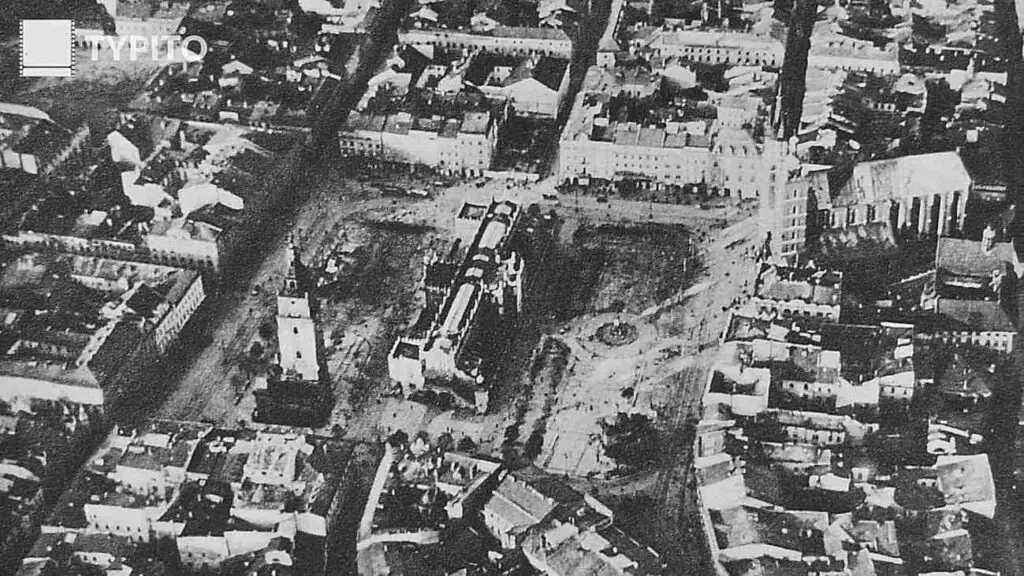
Gothic structure we see today. Along with the new church, a municipal cemetery was needed. Being in line with medieval traditions, the cemetery was established around the church and served as the burial ground for Krakow’s citizens for over 500 years.
The burial ceremonies took place in the parish church until Mikołaj Wierzynek, a city councilor, established a cemetery chapel in 1338 on the necropolis’s eastern edge. The space was later enclosed with a wall. The chapel was expanded between 1394-1399, probably with the funds from Queen Jadwiga, who patronized the saint of good death. A unique practice was followed wherein the dead were buried for ten years, after which their remains were transferred to the crypts of this small temple.
At the end of the 15th century, an interesting turn of events took place – a chapel was set up at the church’s entrance. This chapel for the garden was worked on by the workshop of Veit Stwosz, most likely by his son, Józef.
For centuries, wooden buildings that formed the houses of the sacristans of St. Mary’s Church and partly butchers’ stalls were located on the left side of the temple. These stalls were part of the Small Market, selling meat, raw meat, and half-carcasses of pork.
The Not-So-Serene Times of the Necropolis
Let me say, St. Mary’s Square hasn’t always been the calm and tranquil place it is today. Imagine being there in the past, it was surrounded by bustling town squares on one side and the Little Market Square on the other. It wasn’t exactly an environment for the quiet remembrance of the deceased. The cemetery walls served as hideouts for thieves, cutthroats, and prostitutes. Traders selling poultry and dairy would mingle among the mourners.
Even the porch of St. Mary’s Church was put to unusual use on Sundays. Criminals were confined in a special cell, and those who sinned against the sixth commandment were handcuffed to martens at the southern entrance, located in the cemtery. I think it’s fair to say that the atmosphere wasn’t exactly serene.
There were many pubs near the cemetery which often sparked scandals. One such pub had to be closed in 1524 under clergy pressure. The square was so infamous that it was said:
“Idle girls and debauched lives have multiplied so much that in the evenings almost all the streets, especially the market square and the cemetery of the Virgin Mary and All Saints, fill them with poop and boldly and shamelessly harass passers-by, deceive the innocent and drunk, and search their pockets at the same time.”
Transformation of Buildings Around the Square
Come 1631, there was a change in the architectural landscape of the square. The wooden structures on the north side of the Church of Saint Barbara were replaced with a Baroque curate building. I know you’d find it interesting that this building underwent a dramatic makeover in the mid-18th century. The royal architect, Franciszek Plaaccidi, expanded it and gave it a more refined look.
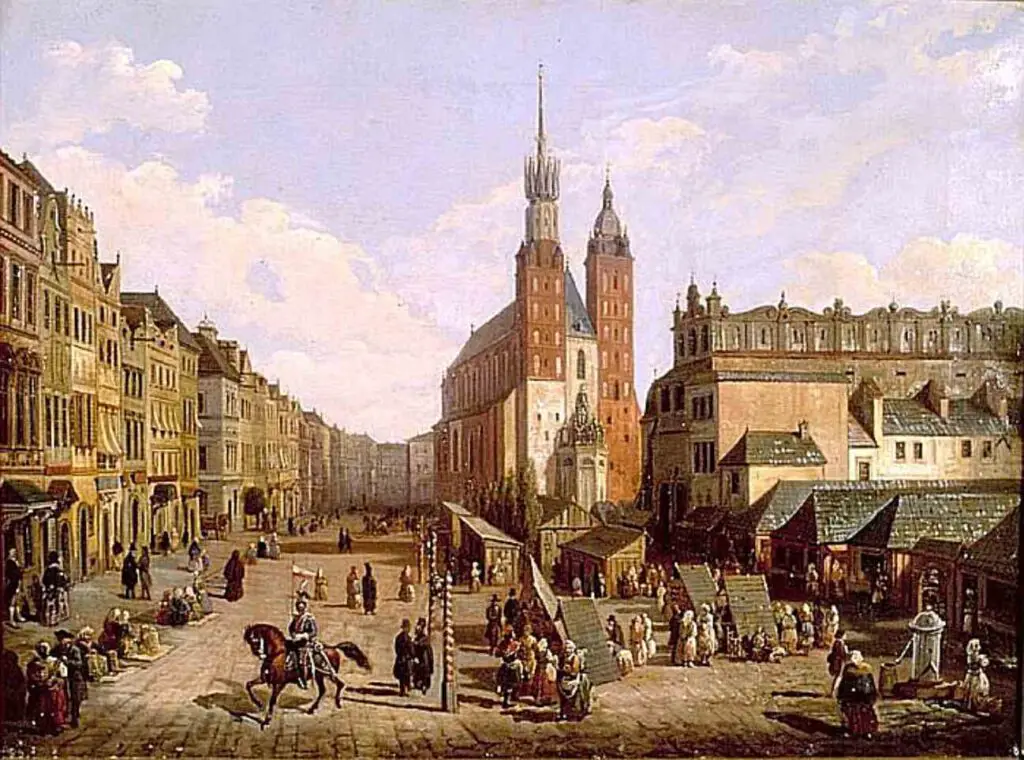
Meanwhile, on the market side, buildings dating back to the Middle Ages were still standing, evolving with the rhythm of market changes.
The Legend of Our Lady of Graces
In 1771, a remarkable event took place. A figure of Our Lady of Graces was created in the studio of Jan Krzyżanowski and placed on the main gate leading to the cemetery. If you want to know the intriguing story behind this, here it is: The figure was commissioned by the mother of a member of the Bar Confederation, a certain Sokołowski, as a vote for saving her son.
According to legend, after one skirmish, Sokołowski was found unconscious and presumed dead. He was placed in a grave near St. Mary’s Church. When he regained consciousness, he saw the image of Our Lady of Grace on a column.
Using his remaining strength, he crawled out of the grave and made his way to the nearby vicar’s house. There, he received help and quickly recovered. It’s a story of faith and resilience that’s been passed down generations.
The End of an Era – Closing the Cemetery
The transformation of the square continued until 1796, when new sanitary regulations came into play. The Austrian authorities prohibited burials within city limits, bringing about a monumental shift in the local customs. By 1803, the cemetery was completely closed down and a new necropolis opened at Racławicka Street.
Throughout the 19th century, St. Mary’s Square remained largely unaltered except for the tenement houses in the Market Square, which underwent several modifications in accordance with prevailing architectural trends. In the mid-18th century, the corner plots with the market square were acquired by the Bartsch family, leading to the area being colloquially known as 'Bartsch’.
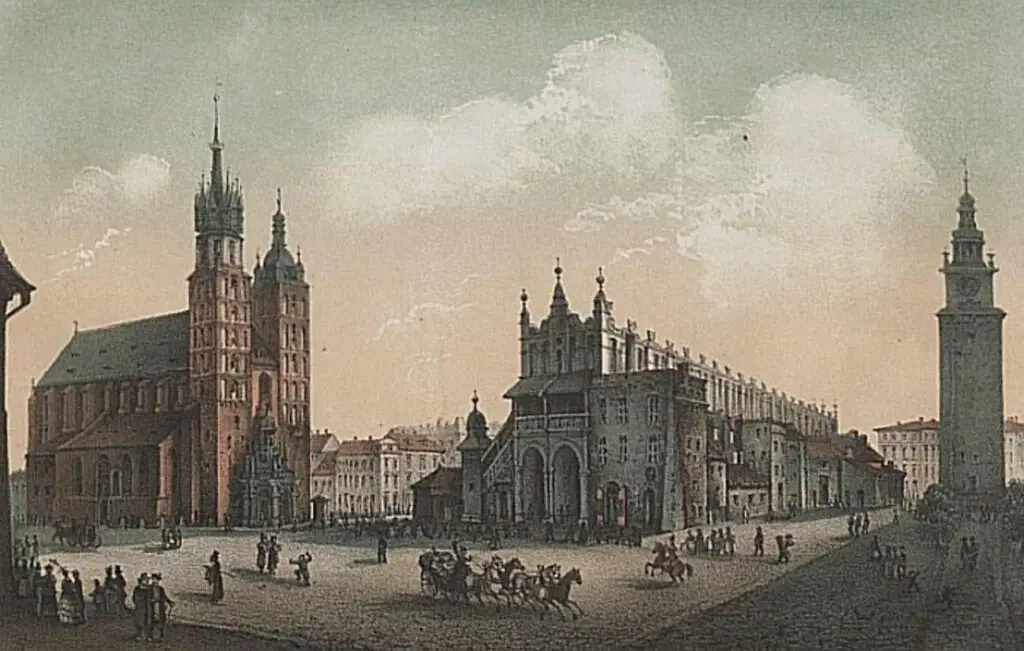
One notable resident of these buildings was Stanisław Wyspiański who rented rooms from the side of St. Mary’s Church in 1901. This location became a hub of creativity, witnessing the birth of some of his iconic works such as „Warszawianka„, „Legion„, „Klątwa„, and a significant portion of the famous „Wesele”. A commemorative plaque designed by Karol Hukan marks this historical significance.
After changing hands again, the property became the responsibility of Krakow merchant, Celestyn Czynciel. He initiated the demolition of the old buildings and replaced them with a new construction, built in the Art Nouveau style that was popular at the time.
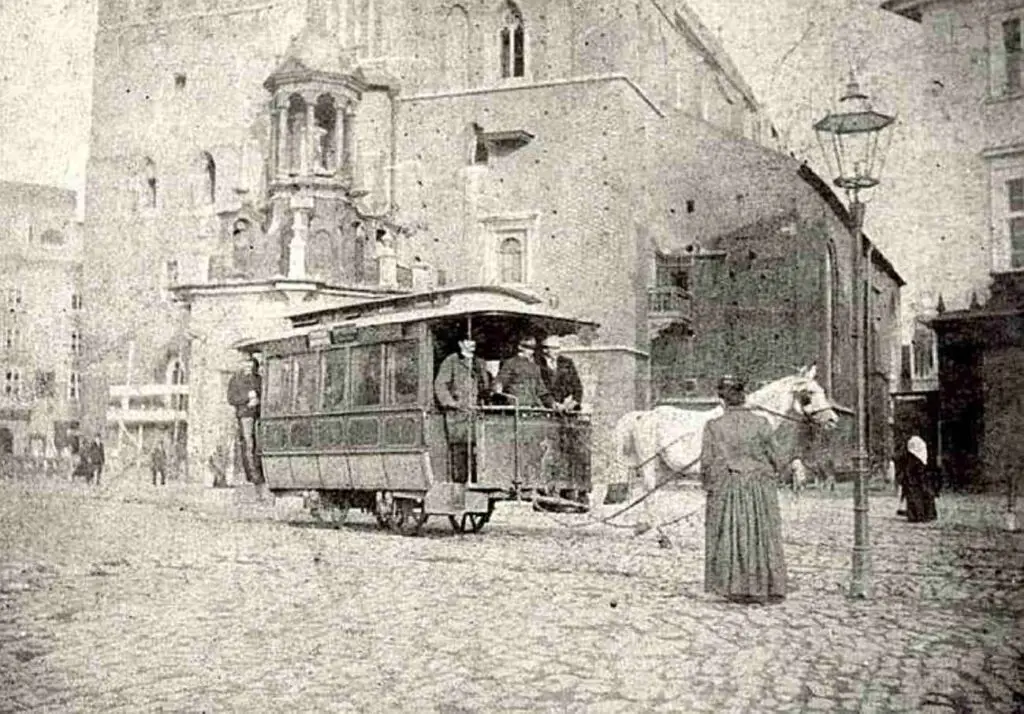
The 20th Century Developments
Fast forward to the first few decades of the 20th century, the majority of the buildings surrounding the square are tenement houses. One notable example is the Czyncielówka, located on the way to the church of Saint Barbara. This building stands as the only tenement house from the period when the cemetery still existed. An arresting feature on its facade is a copy of the bas-relief depicting Christ praying in Gethsemane by Veit Stoss, the original of which resides in the National Museum.
A tenement house constructed in 1912, designed by Wit Stwosz, stands in front of the church. However, behind the Church of Saint Barbara lies the vicar’s building with a passage towards the Small Market Square. This isn’t the building erected by Francesco Placcidi, but rather a newer one. By the beginning of the 20th century, the original building had fallen into such disrepair that its demolition was decided in 1934 to prevent a catastrophic collapse.
The vacant space sparked debates about its future use, but two key arguments prevailed. Firstly, the historical importance of separating St. Mary’s Square from the Small Market Square, and secondly, leaving the space empty would expose an unnatural contrast between the Gothic body of St. Barbara’s Church and its Baroque apse. Consequently, in 1936, a new curate building was erected, designed in a classicist style by Franciszek Mączyński.
The Enigmatic Fountain and the Hidden Side of Mariacki Square
Adding an intriguing charm to the location is the presence of a small fountain, funded by the Krakow guild of craftsmen as a tribute to Wit Stwosz. Known as the pigeon well, its central decoration depicts a Krakow studnt. This sculpture, designed by Jan Budziłło, was inspired by a figure from the grand St. Mary’s altar.
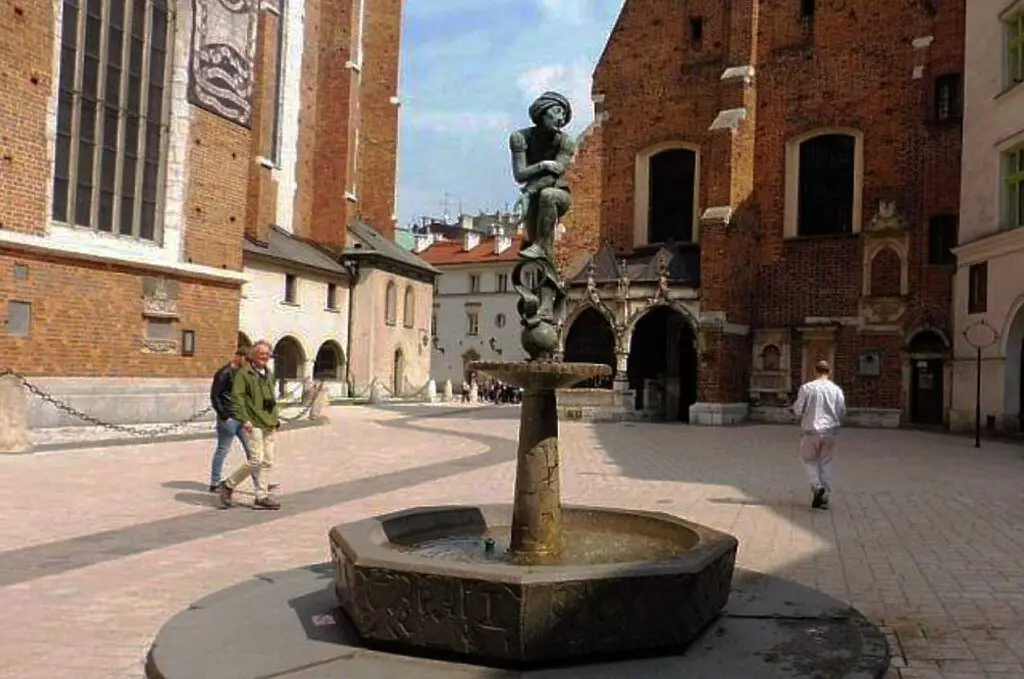
The original figure, not cast in bronze but carved from linden wood, resides among the depicted prophets on the right side of the arch of the arcade crowning the altar cabinet. It’s one of those spots in Krakow that inspires a yearning to return, with a local belief that tossing a coin into the fountain ensures a revisit to the city.
While it may seem like we’ve exhausted the tales of this captivating square, Mariacki Square is also the lesser-visited side of the city parish church. This area, extending from Floriańska Street to Szpitalna Street, is often overlooked by tourists but is equally steeped in historical intrigue. Notably, it served as a burial ground for the Cracovians for several centuries.
A Mysterious Incident – The 1599 Altercation
A tragic incident that took place on this ground still fascinates historians. On March 10, 1599, a deadly dispute unfolded between two nobleman brothers, Jan and Michał Gawroński, and a town tailor named Jan Jarząbek. The specifics of the disagreement remain obscure to this day, and the exact fate of the tailor is shrouded in uncertainty.
The ensuing trial gained considerable attention. It is known that a saber fight broke out in what was then the St. Mary’s Cemetery. Injured by the blade, Jarząbek sought refuge in St. Mary’s parish church, a recognized sanctuary where violence was forbidden.
Despite this, the brothers managed to catch up with him and are believed to have inflicted the fatal wounds. Jarząbek, despite receiving medical treatment, is speculated to have died a few days later. This tale, while grim, adds another layer of intrigue to the historical tapestry of Mariacki Square. The brothers faced judgement for their actions, another tale in the long history of this historic location.
Retracing the Footsteps of the Past -Architectural Narratives
Notably, this side of the square remained largely untouched by the architectural transformations of the late 19th and early 20th centuries. If you wander from Floriańska Street, you’ll find a tenement house at number two. It has a rich history, once serving as the dwelling of the penitentiary priests of the Mariacki parish church, those who would listen to confessions.
The origins of this building stretch back to the late 16th century, and it’s first mentioned in records in 1587. Originally, it was the property of the middle-class family of Zuzanna and Bazyli Ryniewicz. In 1637, they sold the house to the mistresses of Panna Maria. The priests then transformed the house into a Baroque style, and it received its current form in the mid-19th century when it was elevated by a third floor and reshaped into a Classicist style.
Adjacent to this is the intriguing Hipolit House. A veritable testament to changing hands and evolving architectural tastes, it has seen a rich history. Its façade was adorned with sgraffito decoration in the early 17th century. When it later passed to the Zaleski family, they had eminent architect Baltazar Fontanna create an intricate stucco decoration.
The house displays portals from three different eras – Gothic, Renaissance, and Baroque, making it a living museum of architectural styles. Since 2003, it has been under the custodianship of the Historical Museum of the City of Krakow. It hosts an exhibition that narrates the life of wealthy Krakow burghers from the 17th to the 19th century. The name „Kamienica Hipolitów” recalls a family from Italy that owned the property in the 18th century.
The St. Mary’s Prełatówka
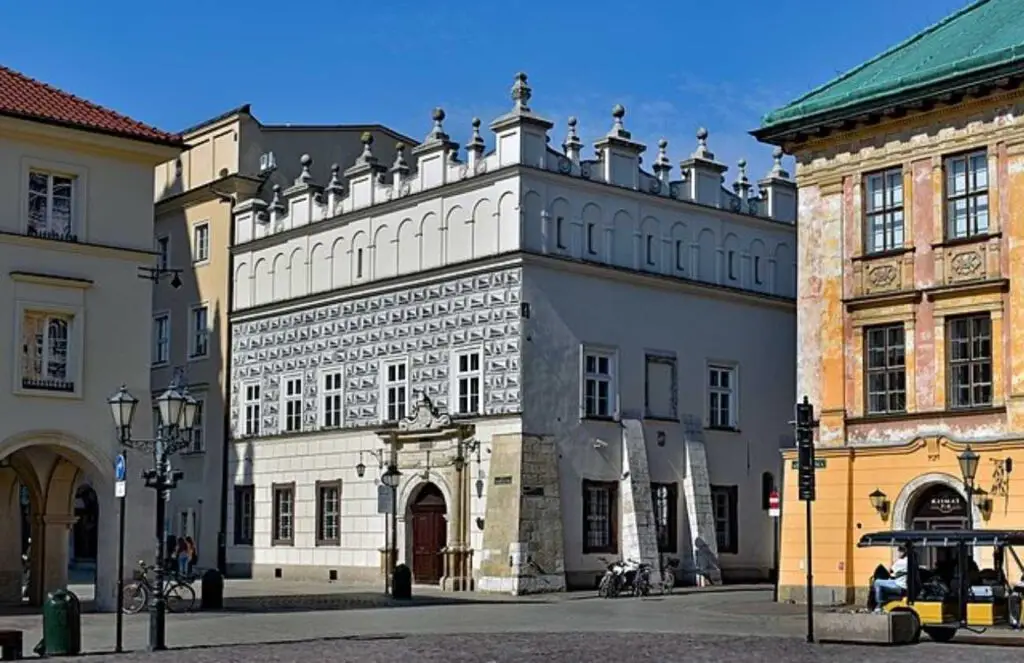
The final noteworthy tenement house on our tour is the Prełatówka of St. Mary’s Church. It was constructed between 1618 and 1619, thanks to the efforts of Marcin Litwinkowicz. This building replaced two earlier Gothic houses and is now topped with an attic, reflective of the Kraków Renaissance, added in 1652. The entrance portal bears a Latin sentence, translating to:
„May the house be open to friends and the poor.”
Thus, our journey through the former parish cemetery, transformed into a charming square, comes to an end. Currently, this area, paved with white Turkish cubes, is most captivating under the glow of the morning sun or just before its descent at sunset. It serves as a meeting spot for lovers in the evening, and during the day, crowds of tourists gather here to hear the bugle call from St. Mary’s.
References:
https://en.wikipedia.org/wiki/St._Mary%27s_Basilica,_Krak%C3%B3w
https://mariacki.com/en/
http://krakow.travel/en/17714-krakow-st-mary-magdalene-square
http://www.krakow.travel/en/17746-krakow-mariacki-square
https://tropter.com/en/poland/krakow/st-marys-square
https://www.inyourpocket.com/krakow/plac-mariacki_148768v


